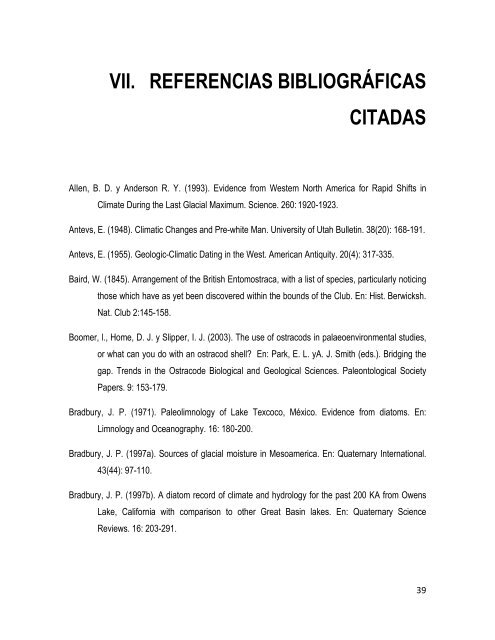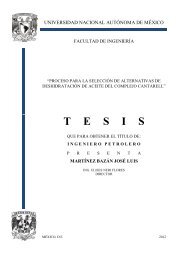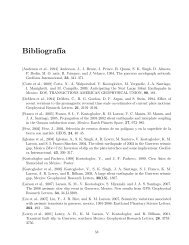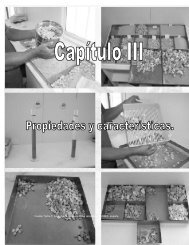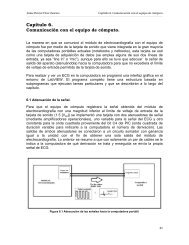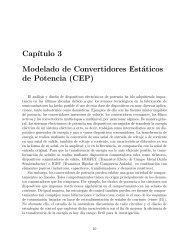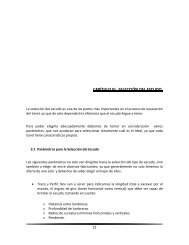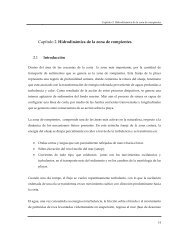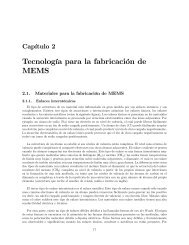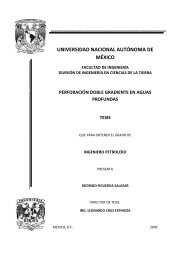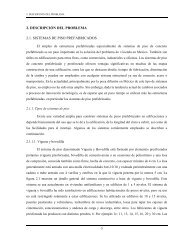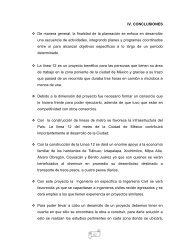VII. REFERENCIAS BIBLIOGRÃFICAS CITADAS - UNAM
VII. REFERENCIAS BIBLIOGRÃFICAS CITADAS - UNAM
VII. REFERENCIAS BIBLIOGRÃFICAS CITADAS - UNAM
- No tags were found...
You also want an ePaper? Increase the reach of your titles
YUMPU automatically turns print PDFs into web optimized ePapers that Google loves.
<strong>VII</strong>. <strong>REFERENCIAS</strong> BIBLIOGRÁFICAS<strong>CITADAS</strong>AlIen, B. D. y Anderson R. Y. (1993). Evidence from Westem North America for Rapid Shifts inClimate During the Last Glacial Maximum. Science. 260: 1920-1923.Antevs, E. (1948). Climatic Changes and Pre-white Man. University of Utah Bulletin. 38(20): 168-191.Antevs, E. (1955). Geologic-Climatic Dating in the West. American Antiquity. 20(4): 317-335.Baird, W. (1845). Arrangement of the British Entomostraca, with a list of species, particularly noticingthose which have as yet been discovered within the bounds of the Club. En: Hist. Berwicksh.Nat. Club 2:145-158.Boomer, l., Home, D. J. y Slipper, I. J. (2003). The use of ostracods in palaeoenvironmental studies,or what can you do with an ostracod shell? En: Park, E. L. yA. J. Smith (eds.). Bridging thegap. Trends in the Ostracode Biological and Geological Sciences. Paleontological SocietyPapers. 9: 153-179.Bradbury, J. P. (1971). Paleolimnology of Lake Texcoco, México. Evidence from diatoms. En:Limnology and Oceanography. 16: 180-200.Bradbury, J. P. (1997a). Sources of glacial moisture in Mesoamerica. En: Quaternary International.43(44): 97-110.Bradbury, J. P. (1997b). A diatom record of climate and hydrology for the past 200 KA from OwensLake, California with comparison to other Great Basin lakes. En: Quaternary ScienceReviews. 16: 203-291.39
Bradbury, J. P. (2000). Limnologic history of Lago de Pátzcuaro, Michoacán, México for the past48,000 years: Impacts of climate and man. En: Palaeogeography, Palaeoclimatology,Palaeoecology. 163: 69-95.Bradbury, J. P., Grosjean, M. A., González, S., Stine, S., y Sylvestre, F. (2000). Full- and late-glaciallake records along the PEP1 transect: Their role in developing interhemispheric paleoclimateinteractions. En: Interhemispheric Climate Linkages (V. Markgraf, Ed.), pp. 265-289.Academic Press, San Diego.Bradley, R. S. (1999). Paleoclimatology. Reconstructing Climates of the Quaternary, 2nd ed.International Geophysics Series, Volume 64. San Diego, London, Boston, New York,Sydney, Tokyo, Toronto: Academic Press.Bradley, R. S. y Eddy, J. A. (1991). Records of past global changes. En: Global Changes of the Past(ed. R.S. Bradley) University Corporation for Atmospheric Research, Boulder. pp. 5-9.Brady, G. S. (1868). A synopsis of the Recent British Ostracoda. En: Intell. Obser. 12: 110-130.Caballero-Miranda, M. E., y Ortega-Guerrero, B. (1998). Lake levels since about 40,000 years ago atLake Chalco, near México City. En: Quaternary Research. 50: 69-79.Caballero-Miranda, M. E., Lozano, S., Ortega, B., Urrutia, J., y Macías, J. L. (1999). Environmentalcharacteristics of Lake Tecocomulco, northern basin of México, for the last 50,000 years. En:Journal of Paleolimnology. 22: 399-411.Carreño, A. L. (1990). Ostrácodos lacustres del paleolago de Texcoco. Revista de la SociedadMexicana de Paleontología. 3(1): 117-135.Chivas, A. R., De Deckker, P. y Shelley, J. M. G. (1983). Magnesium, strontium and bariumpartitioning in nonmanne ostracode shells and their use in paleoenvironmentalreconstructions- A preliminary study. En: Maddocks, R. F. (ed.). Applications of Ostracoda.Univ. Houston Geosc. pp. 283-249.Chivas, A. R., De Deckker, P. y Shelley, J. M. G. (1985). Strontium content of ostracods indicateslacustrine palaeosalinity. En: Nature. 316: 251-253.40
Chivas, A. R., De Deckker, P. y Shelley, J. M. G. (1986a). Magnesium content of nonmarineostracode shells: A new palaeosalinometer and palaeothermometer. En: Palaeogeography,Palaeoclimatology, Palaeoecology. 54: 43-61.Chivas, A. R., De Deckker, P. y Shelley, J. M. G. (1986b). Magnesium and strontium in non-marineostracod shells as indicators of palaeosalinity and palaeotemperature. En: Hydrobiologia.143: 135-142.Clement, A. C., Seager, R. y Caneo, M. A. (2000). Supression of El Niño during the mid-Holocene bychanges in the Earth's orbit. En: Paleoceanography. 15(6): 731-737.Curry, B. (1999). An environmcntal tolerance index for ostracods as indicators ofphysical andchcmical factors in aquatic habitats. En: Palaeogeography, Palaeoclimatology,Palaeoecology. 148: 51-63.Danielopol, D. L., Ito, E., Wansard, G., Kamiya, T., Cronin, T. M., y BaItanás, A. (2002). Techniquesfor Collection and Study of Ostracoda. En: J. A. Holmes, A. R. Chivas (Eds.). The Ostracoda:Applications in Quaternary Research. Washington DC: The American Geophysical Union. pp.65-97.Davis, O. K. (1984). Multiple Thermal Maxima During Holocene. Science. 225: 617-619.Delorme, D. L. (1967). New freshwater Ostracoda from Saskatchewan, Canada. En: CanadianJournal of Zoology. 46(5): 859-876.Delorme, D. L. (1971a). Freshwater ostracodes of Canada. Part 11. Subfamily Cypridopsinae andHerpetocypridinae, and family Cyclocyprididae. En: Canadian Joumal of Zoology. 48: 253-266.Delorme, D. L. (1971b). Freshwater ostracodes of Canada. Part 111. Family Candonidae. En:Canadian Joumal ofZoology. 48: 1099-1127.Delorme, D. L. (1971c). Freshwater ostracodes of Canada. Part V. Families Limnocytheridae,Loxoconchidae. En: Canadian Joumal of Zoology. 49: 43-64.41
Delorme, D. L. (1989). Methods in Quatemary ecology #7: Freshwater ostracodes. En: GeoscienceCanada.16: 85-90.De Deckker, P. (1988). An account of the techniques using ostracodes in paleolimnology in Australia.Palaeogeography, Palaeoclimatology, Palaeoecology. 62: 463-475.De Deckker, P. y Forester, R. M. (1988). The use of ostracodes to reconstruct continentalpaleoenvironmental records. En: De Deckker, P.; J. P. Colin y J.P. Peypouquet (eds.).Ostracoda in the Earth Sciences. EIsevier, Amsterdam. pp. 176-199.Engstrom, D. R. y Nelson, S. R. (1991). Paleosalinity from trace metals in fossil ostracodescompared with observational records at Devils Lake, North Dakota, USA. En:Palaeogeography, Palaeoclimatology, Palaeoecology. 83: 295-312.Forester, R. M. (1983). Relationship of two lacustrine ostracode species to solute composition andsalinity: Implications for paleohydrochemistry. En: Geology. 11: 435-438.Forester, R. M. (1985). Limnocythere bradburyi n. sp; a modern ostracode from Central México andpossible Quaternary paleoclimatic indicator. En: Journal of Paleontology. 59(1): 8-20.Forester, R. M. (1987). Late Quaternary paleoclimate records from lacustrine ostracods. En:Ruddiman, W. F. y H. E. Jr. Wright (eds.). North America and adjacent oceans during the lastdeglaciation: Boulder, Colorado. Geological Society of America, The Geology ofNorthAmerica. K-3: 261-276.Forester, R. M. (1991). Ostracode assemblages from springs in the western United States:lmplications for paleohydrology. En: Memories of the Entomological Society of Canada. 155:181-201.Hartmann, G. y Puri, H. S. (1974). Summary of neontological and paleontological classification ofOstracoda. En: Mitteilungen aus dem Hamburgischen Zoologischen Museum und Institut. 70:7-73.42
Hawley, J. W. (1969). Notes on the geomorphology and Late Cenozoic geology of northwesternChihuahua. En: Guidebook of the Border Region, Chihuahua and the United States. 20: 132-138.Holmes, J . P. (1992). Nonmarine ostracodes as Quaternary paleoenvironmental indicators. En:Progress in Physical Geography. 16: 425-431.Holmes, J. P. (2001). Ostracoda. En: Smol, J. P.; H. J. B. Birks y W. M. Last (eds.). TrackingEnvironmental Change Using Lake Sediments, Vol. 4, Zoological Indicators. KluwerAcademic Publishers. Holanda. pp. 125-151.Johnsson, M. J., Stallard, R. F. y Meade, R. H. (1988). First-cycle quartz arenites in the OrinocoRiver basin, Venezuela and Colombia. En: Journal of Geology. 96: 263-277.Kaufmann, A. (1900). Cypriden und Darwinuliden der Schweiz. En: Revue Suisse de Zoologie. 8:209-423.Latreille, P. A. (1806). Genera crustaceorum et insectorum secundum ordinem naturalem in familiasdisposita, iconibus exemplisque plurimis explicata. Parisiis: A. Koenig.Lozano-García, M. S., Ortega-Guerrero, B., Caballero-Miranda, M., y Urrutia-Fucuguachi, J., 1993.Late Pleistocene and Holocene paleoenvironments of Chalco Lake, central México. En:Quaternary Research 40: 332–342.Maddocks, R. F. (1982). Ostracoda. En Hessler, R. R., Marcotte, B. M., Newman, W. A. y Maddocks,R. F., editoriales, Evolution within the Crustacea. En Abele, L. G., editorial, Biology of theCrustacea, Volume 1. Systematics, the fossil record and biogeography, New York: AcademicPress. pp. 221-39.McLennan, S. M. (1993). Weathering and global denudation. En: Journal of Geology. 101: 295-303.Menking, K. M. y Anderson, R. Y. (2003). Contributions of La Niña and El Niño to middle Holocenedrought and Late Holocene moisture in the American Southwest. Geology. 31(11): 937-940.43
Metcalfe, S. E., O'Hara, S. L., Caballero M. y Davies S. J. (2000). Records of Late Pleistocene-Holocene climatic change in México - a review. En: Quaternary Science Reviews. 19: 699-721.Metcalfe, S. E., Bimpson, A., Courtice, A. J., O'Hara, S. L. y Taylor, D. M. (1997). Climate Change atthe monsoon/Westerly boundary in Northern Mexico. En: Journal of Paleolimnology. 17: 155-171.Metcalfe, S. E., Say, A., Black, S., McCulloch, R. y O'Hara, S. (2002). Wet conditions during the LastGlaciation in the Chihuahuan Desert, Alta Babicora Basin, México. En: Quaternary Research.57: 91-101.Meyer, E. R. (1973). Late Quaternary paleoecology of the Cuatro Cienegas basin, Coahuila, Mexico.En: Ecology. 54: 982-995.Moore, R. C. (1961). Treatise on invertebrate paleontology, part Q, Arthropoda 3, Crustacea –Ostracoda. En: Geological Society of America and University of Kansas Press.Müller, G. W. (1894). Die ostracoden des Golfes von Neapel und der angrezenden Meeres-Abschnitte. En: Fauna Flora des Golfes Neapel, Monograph. 21: 404.Müller, O. F. (1776). Zoologie Danicae prodromus, seu animalium Daniae et Norvegiae indigenarum,characteres, nomina, et synonyma imprimis popularium. En: Haveniae, Typis Hallageriis. pp.198-199.Nesbitt, H. W. y Young, G. M. (1982). Early Proterozoic climates and plate motions inferred frommajor element chemistry of lutitas. En: Nature. 299: 715-717.Nordt, L. (2003). Late Quatemary fluvial landscape evolution in desert grasslands of northernChihuahua, México. En: GSA Bulletin. 115(5): 596-606.Ortega-Ramirez, J. R. 1995. Los paleoambientes holocénicos de la Laguna de Babícora, Chihuahua,México. En: Geofísica Internacional. 34(1): 107-116.44
Ortega-Ramírez, J. R., Urrutia-Fucugauchi, J. y Valiente-Banuet, A. (2000). The Laguna de Babícorabasin: a late Quaternary paleolake in northwestern Mexico. En: Gierlowski-Kordesch E. H. YK. R. Kelts (eds.). Lake basins through space and time: AAPG Studies in Geology. 46: 569-580.Ortega-Ramírez, J. R., Urrutia-Fucugauchi, J. y Valiente-Banuet, A. y Mortera-Gutiérrez, C. (1998).Paleoclimatic Changes during the late Pleistocene-Holocene in Laguna Babícora, near theChihuahuan Oesert, México. En: Canadian Journal of Earth Sciences. 35: 1168-1179.Palacios-Fest, M. R. (1994). Nonmarine ostracode shell chemistry from Ancient Hohokam irrigationcanals in Central Arizona: a paleohydrochemical tool for the interpretation of prehistorichuman occupation in the North American Southwest. En: Geoarchaelogy; An InternationalJournal. 9(1): 1-29.Palacios-Fest, M. R. (1996). Geoquímica de las conchas de ostrácodos (Limnocythere staplini) unmétodo de regresión múltiple como indicador paleoambiental. En: GEOS. 16(3): 130-136.Palacios-Fest, M. R. y Dettman, D. L. (2001). Temperature controls monthly variation in Ostracodevalve Mg/Ca: Cypridopsis vidua from a small lake in Sonora, México. En: Geochimica etCosmochimica Acta. 65(15): 2499-2507.Palacios-Fest, M. R., Cohen, A. S. y Anadón, P. (1994). Use of ostracodes as paleoenvironmentaltools in the interpretation of ancient lacustrine records. En: Revista Española dePaleontología. 9(2): 145-164.Palacios-Fest, M. R., Carreño, A. L., Ortega-Ramírez, J. R. y Alvarado-Valdéz, G. (2002). Apaleoenvironmental reconstruction of Laguna Babícora, Chihuahua, México, based onostracode paleoecology and trace element shell chemistry. En: Journal of Paleolimnology.27: 185-206.Palacios-Fest, M. R., Cohen, A. S., Ruíz, J. y Blank, B. (1993). Comparative paleoclimaticinterpretations from nonmarine ostracodes using faunal assemblages, trace elements shellchemistry and stable isotope data. En: Geophysical Monograph. 78: 179-190.45
Reimer, P. J., Baillie, M. G., Bard, E., Bayliss, A., Beck, J. W., Blackwell, P.G., Bronk-Ramsey, C.,Buck, C. E., Burr, G. S., Edwards, R. L., Friedrich, M., Grootes, P. M., Guilderson, T. P.,Hajdas, I., Heaton, T. J., Hogg, A. G., Hughen, K. A., Kaiser, K. F., Kromer, B., Mc-Cormac,F. G., Manning, S. W., Reimer, R. W., Richards, D. A., Southon, J. R., Talamo, S., Turney, C.S. M., Van der Plicht, J. y Weyhenmeyer, C. E. (2009). IntCal09 and Marine09 radiocarbonage calibration curves, 0–50,000 years cal BP. En: Radiocarbon. 51(4): 1111–50.Reyes-Torres, A. y Vázquez-Rodríguez, S. D. (2003). Determinación taxonómica y geoquímica de laconcha de los ostrácodos fósiles pertenecientes al Plioceno presentes en SanctorumHidalgo, México. Tesis de Licenciatura, Facultad de Estudios Superiores, Zaragoza, <strong>UNAM</strong>.Distrito Federal.Roy, P. D., Caballero, M., Lozano, R. y Smykatz-Kloss, W. (2008). Geochemistry of Late Quaternarysediments from Tecocomulco lake, central México: implication to chemical weathering andprovenance. En: Chemie der Erde-Geochemistry. 68,4:383-393.Roy, P. D., Caballero, M., Lozano, R., Pi, T., Morton, O. (2009). Late Pleistocene-Holocenegeochemical history inferred from Lake Tecocomulco sediments, Basin of México, México.En: Geochemical Journal. 43: 49-64.Roy, P. D., Pérez-Cruz, L. L, Chávez-Lara, C. M., Salas de León, D. A. y Romero, F. M. (2010).Periodicities of solar forcing in a century scale high resolution sedimentary register fromChihuahua Desert, México. En: Reunión Anual 2010 de la Unión Geofísica Mexicana.Roy, P. D., Caballero, M., Lozano, M. S., Morton, O., Lozano, R., Jonathan, M. P., Sánchez-Zavala,J. L. y Macías, M. C. (2011). Provenance of sediments deposited at paleo-lake San Felipe,western Sonora Desert: implications to regimes of winter and summer rainfall during last 50cal kyr BP. En: Journal of Arid environments.Ruíz, F., González-Regalado, M. L., Muñoz, J. M., Pendón, J. G., Rodríguez-Ramírez, A., Cáceres,L. y Rodríguez-Vidal, J. (2003). Population age structure and ostracods: Applications incoastal hydrodinamics and paleoenvironmental analysis. En: Palaeogeography,Palaeoclimatology, Palaeoecology. 199: 51-69.46
Sars, G. O. (1866). Oversigt of Norges marine Ostracoder, in Forhandlinger i Videnskabs-Selskabet iChristina. En: Norske Vidensk. Akad. Forhandlinger. pp. 1-130.Stuiver, M. y Reimer, P.J. (1993). Extended 14 C data base and revised CALIB 3.0 14 C age calibrationprogram, En: Radiocarbon. 35: 215-230.Tressler, W. L. (1954). Fresh-water Ostracoda from Texas and México. En: Journal of theWashington Academy of Science. 44: 138-149.Turpen, J. B. y Angell, R. W. (1971). Aspects of molting and calcification in the ostracodHeterocypris. En: Biological Bulletin. 140: 331-338.Urrutia-Fucugauchi J., Ortega-Ramírez, J. y Cruz-Gatica, R. (1997). Rock-magnetic study of LatePleistocene-Holocene sediments from the Babícora lacustrine basin, Chihuahua, northernMéxico. En: Geofísica Internacional. 36(2): 77-86.Van Devender, T. R. (1990). Late Quatemary vegetation and climate of the Chihuahuan Desert,United States and México. En: Betancourt, J. L., Van Devender, T. R. y Martin, P. (eds.).Packrat Middens: The Last 40,000 years of Biotic Change. University of Arizona Press,Tucson. pp. 105-133.Van Devender, T. R. (1990b). Late Quatemary vegetation and climate of the Sonaran Desert, UnitedStates and Mexico, En: Betancourt J. L.; T. R. Van Devender y P. Martin (eds.). PackratMiddens: The Last 40,000 years of Biotic Change. University of Arizona Press, Tucson. pp.135-136.Van Devender, T. R. y Spaulding, W. G. (1979). Development of Vegetation and Climate in theSouthwestem United States. En: Science. 204: 701-710.Van Morkhoven, F. P. C. M. (1963). Post-Paleozoic Ostracoda. Their morphology, taxonomy andeconomic use. EIsevier Publishing Company. Nueva York.Waters, M. R. y Haynes, C. V. (2001). Late Quatemary arroyo formation and climate change in theAmerica Southwest. En: Geology. 29(5): 399-402.47
Watts, W. A., y Bradbury, J. P. (1982). Paleoecological studies at Lake Patzcuaro on the west-centralMexican plateau and at Chalco in the Basin of Mexico. En: Quaternary Research. 17: 56-70.Xia , J., Engstrom, D. R. y Ito, E. (1997). Geochemistry of ostracode calcite: Part 2. The effect ofwater chemistry and seasonal temperature variation on Candona rawsoni. En: Geochimica etCosmochimica Acta. 61: 383-391.48


